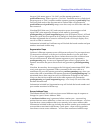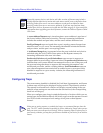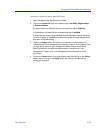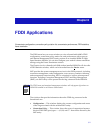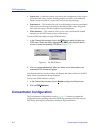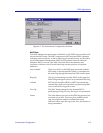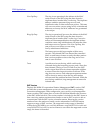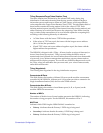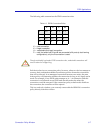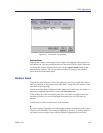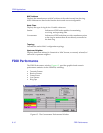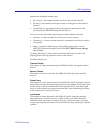
FDDI Applications
6-4 Concentrator Configuration
Non-Op-Dup The ring is not operational; the address of the MAC
under control of the SMT entity has been found to
duplicate that of another MAC on the ring. The duplicate
address condition prevented ring recovery and
initialization after a claim and beacon process. This state
will not occur unless you are using locally- administered
addresses, as factory-set MAC addresses are guaranteed
to be unique.
Ring-Op-Dup The ring is operational; however, the address of the MAC
under control of the SMT entity has been found to
duplicate that of another MAC on the ring. Corrective
actions will be attempted before the duplicate address
condition causes ring initialization to fail after the claim
and beacon recovery process. Like Non-Op-Dup, this
state will not occur unless you are using
locally-administered addresses.
Directed The beacon process did not complete within seven
seconds. The selected SMT has directed the controlled
MAC to send beacon frames to notify the other stations
that a serious problem exists on the ring, and a Trace
state is soon to follow.
Trace A problem exists on the ring which could not be
corrected during the beaconing process, and a Trace has
been initiated. During a Trace (or Path Test), the SMT
sends a signal that forces its nearest upstream neighbor
to remove from the ring and conduct a self-test. If the
ring does not recover, each subsequent upstream station
will be forced to remove from the ring and conduct
self-tests until the problem has been corrected. While the
test is being conducted, ring management re-enters the
isolated state.
SMT Version
Displays the HSIM-F6Õs operational Station Management (SMT) version. SMT
provides the system management services for the FDDI protocols, including
connection management, node conÞguration, error recovery, and management
frame encoding. SMT frames have a version ID Þeld that identiÞes the structure
of the SMT frame Info Þeld. The version number is included in the SMT frame so
that a receiving station can determine whether or not its SMT version is able to
communicate with the SMT version of another station. Knowing the version
number allows the stations to handle version mismatches. Each FDDI station
supports a range of SMT versions. The supported version range is identiÞed
within the ietf-fddi MIB by two smtTable attributes: snmpFddiSMTLoVersionId and
snmpFddiSMTHiVersionId. If a received frame is not within the supported version
range, the frame is discarded.




